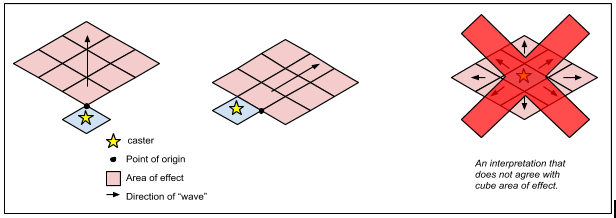5.0 House Rules & Clarifications
I typically do not like to add house rules to the game. Ideally the published rules would be all that is needed - but in reality some things will need adjustments or clarifications.
Custom inspiration system - not currently in effect
One D&D Inspiration Rules
DMG Hero Points - not currently in effect
Areas of Effect on a Grid
For PnP games, I will use Xanthar’s Guide to Everything method of placing tokens to mark areas of effect.
Artisian's Blessing (Forge Cleric)
RAW Forge Cleric’s Artisian’s Blessing (AB) would not allow the creation of a silvered anything out of nothing. However, in addition to weapons, armor, tools, etc. AB allows you to craft “… or another metal object”. So, AB can be used to craft a “silver coating” (aka “another metal object”) onto an already existing weapon. Because applying a sliver coating is 100gp (within the max cost limit of AB) this "works".
Cones (Clarification).
In 5e (PHB 204):- Cone shape is “...width is equal to the distance from the caster” (A 53.13 degree arc).
- Cone “...extends in a direction you choose”.
Death and Dying
Work in progressFirearms
- Proficiency - characters and creatures are not inherently proficient with firearms, it must be purchased with the Weapon Master feat (PHB) or the Gunslinger Feat (NEW) or granted in a monsters stat block.
- Modern Firearms (DMG) are not "priceless", but they are also not "readily available" They are treated as Uncommon magic items in terms of locating them or selling them (see downtime revisited in Xanthars).
- Futuristic firearms and ammo remain "priceless" and "Alien Technology"
- At character creation, Fighters, Paladins, Rangers can trade their Martial Weapons Proficiency for the Gunslinger Feat (NEW)
- Per DMG pg 267, Firearm ammunition is destroyed upon use and can't be recovered.
- Per DMG pg 267, the Reload weapon property is used.
- Non-Light Firearms may at times gain the Misfire attribute (see below) usually due to harsh conditions.
Misfire (non-light firearms only)
Whenever you make an attack roll with a non-firearm, and the dice roll is equal to or lower than the weapon’s Misfire score, the weapon misfires. The attack misses, and the weapon cannot be used again until you spend an action to try and repair it. To repair your firearm, you must make a successful Tinker’s Tools check (DC equal to 8 + misfire score). If your check fails, the weapon is broken and must be mended out of combat at a quarter of the cost of the firearm. Creatures who use a firearm without being proficient increase the weapon’s misfire score by 1.Misfire scores
| Renaissance era firearm | Misfire 3 |
| Modern era firearm | Misfire 2 |
| Futuristic era firearm | Misfire 1 |
Explosives
Renaissance Explosives (DMG) are only available to those with the Demolitionist feat at the price indicated. For others they are treated as uncommon magic items in terms of locating them or selling them (see downtime revisited in Xanthars). Modern Explosives (DMG) are not "priceless", but they are also not "readily available" They are treated as Rare (Uncommon if you have the Demolitionist feat) magic items in terms of locating them or selling them (see downtime revisited in Xanthars).Grappling & dropping targets into danger
You can not simply “release” somebody from a grapple effectively throwing or dropping them into a falling situation. There are already rules for doing that (Shoving a creature, PHB 195, Fighter’s Push Attack maneuver, et. al.).Hiding Material Components (House Rule)
As an action, an opposed Sleight of Hand check might hide the use of some material components (Observers add the level of the spell slot used to their roll or passive perception, other situational modifiers may apply). As an action, an opposed Sleight of Hand check might hide somatic gestures (Observers add the level of the spell slot used to their roll, or passive perception). As an action, a Deception check (opposed by Perception) might hide Verbal components (Observers add the level of the spell slot used to their roll, or passive perception).Initiative Systems
If the group is inexperienced or 1st level - I will use the classic initiative system from the core rules. If the group is experienced, I often switch to a "Re-roll initiative every round" rule. Sometines the order is kept secret. This adds and element of unpredictability to games, but also makes them more dangerous.Inspiration
Several versions are being tested:
Magic Item Identification (House Rule)
Pg. 136 of DMG - The DMG adds the following core rules which need clarification in 100 Worlds:- Magic item properties can automatically be learned simply by spending time with a (non-potion) item during a Short Rest (“Short Rest Identification”).
- Potion properties can be identified simply by “tasting”.
- “Wearing” or “experimentation” can reveal clues about the item (but not full identification).
Short Rest Identification:
Success is not automatic. Following a short rest PCs can make an Intelligence (Arcana) check (DC is based on item rarity) to identify and item.- Common DC ~10
- Uncommon DC ~15
- Rare DC ~20
- Very Rare DC ~25
- Legendary DC ??



Comments